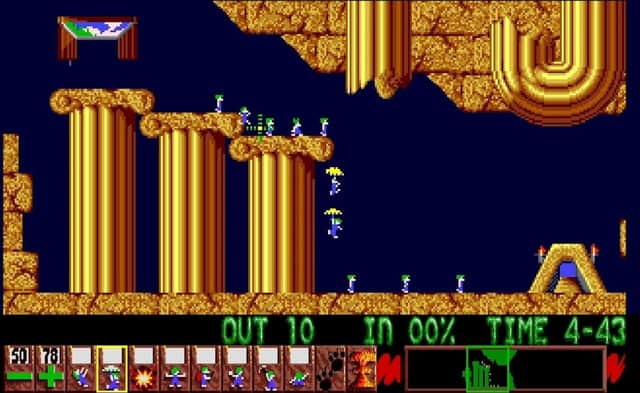'We were basically The Big Bang Theory but 30 years ago': the Dundee developers who became Scottish video game legends with Lemmings


Scottish video games company DMA Design is known far and wide for getting snapped up by Rockstar, the industry titan synonymous with games like Grand Theft Auto and Red Dead Redemption. But it can sometimes be easy to forget that it was the slightly strange strategy game Lemmings which first put the company on the map.
Enjoyed by generation after generation since the first version debuted in 1991, Lemmings presented a novel gameplay format for the time. In a market saturated with video games with a ‘shoot-up’, combat-style gameplay, it cut through with its unique ‘save-up’ offering - allowing users to save the awkward, small and suicidal lemmings as they followed each other off various cliffs and precipices.
Advertisement
Hide AdAdvertisement
Hide AdThe Lemmings’ cries of ‘Oh No!’ when falling to their deaths one after another became an iconic sound in itself, alongside the game’s reliance on unlicensed tunes like ‘How Much is That Doggie in the Window?’ to keep production costs low and profits high.


“It's almost grown over time to become more iconic,” said Jon Dye who, as a young developer at DMA Design, took it upon himself to rewrite the game for the ZX Spectrum.
“I think it took a bit of time to find its place and get its recognition, but it got there in the end.”
As a teen, Jon had attended the computer club at Dundee’s Kingsway Technical College where he met Dave Jones, founder of DMA, and other key players in the future DMA Design team. Jon remarked that when he later arrived at DMA Design in 1991 as a freelance coder and a young student at St Andrews University, it did not feel a whole lot different.
“It didn't feel like a company or anything like that, it was just like being at a computer club,” he said.


“We were basically The Big Bang Theory but 30 years ago. We didn’t drink, basically lived in the Pizza Hut around the corner and just went to the cinema all the time.”
Jon’s lifelong passion for coding had previously seen him create his own code compiler, which would take simple code and convert this into machine code for computers like the ZX Spectrum, Amiga 1000 or the Commodore 64. Naming this ‘HAL’ after Stanley Kubrick’s wayward computer in 2001: A Space Odyssey, Jon sold his compiler in the back of computer magazines, planting the seed for his later role at DMA Design.
Having spent his teens repeatedly wearing out Spectrums, and cycling to the nearby Timex factory to replace the famously “Dundee machine” with a new version, Jon found himself as a freelance coder at DMA wanting to convert the popular Amiga version of Lemmings for the ZX Spectrum.
Advertisement
Hide AdAdvertisement
Hide AdThis daunting task involved scaling the game down to size in a myriad of ways; rewriting Lemmings from a 16-bit version full of colour and up to 100 lemmings for an 8-bit alternative with a limited colour palette and around a third of the lemmings marching across the screen. But despite raised eyebrows, Jon was determined to give it a go.


"Of course, once the original versions came out in ’91 the race was on to get all the other versions out as quickly as possible,” he recalled. “It took me about 18 months altogether and was an arduous process, so came out a fair while after the original first debuted.”
While Lemmings had already become a storming success following the release of Amiga and PC versions in 1991, with an estimated 55,000 sales on the first day alone, Jon’s Spectrum version was released later in 1992 – more critically successful than commercial. Nonetheless, Jon’s code for the Spectrum edition is woven into the game’s history, having set the groundwork for later editions like the arcade and PalmPilot versions.
Having departed from the games industry just as DMA Design soared to new heights of fame with Grand Theft Auto, Jon, now head of assurance services at Heriot-Watt University said: “The dream we all always had was to be playing or making a game in your bedroom that could someday become a hit. But the idea that you could just go and do that all on your own was so exciting.
"You couldn’t really do it in the same way after that because the industry quickly became concerned with big budget, blockbuster games and the bigger companies behind them.”
“We had no idea that we were going to change anything or become a part of history in the way we did,” said Steve Hammond, who worked on the game’s graphics at DMA Design and faced a similar challenge to Jon in converting Lemmings’ graphics for the Atari Lynx and for the PC’s Colour Graphics Adapter and Enhanced Graphics Adapter card modes.
“There’s something about being able to save something,” he said of the game’s enduring appeal. "But it’s funny to me now that I’m an expert in a technique that has absolutely no relevance in the modern world anymore. It’s completely and totally obsolete.”
An early evocation of the sandbox format which cemented Grand Theft Auto’s appeal for players, letting them tear through boundless criminal underworlds with reckless abandon, Steve explained that the secret to Lemmings’ success was that “it wasn’t a game, it was a toy”.
Advertisement
Hide AdAdvertisement
Hide Ad"There was nothing that stopped you from messing about and playing just for the hell of it,” he said.
Led by Dave Jones, the guys behind Lemmings, including Russell Kay, Mike Dailly, Scott Johnston, Gary Timmons, Steve, Jon and more, paved the way for Scotland’s unique, pioneering position in the vast and varied video games landscape, with many young, creative Scottish games developers following in their footsteps today.
Comments
Want to join the conversation? Please or to comment on this article.